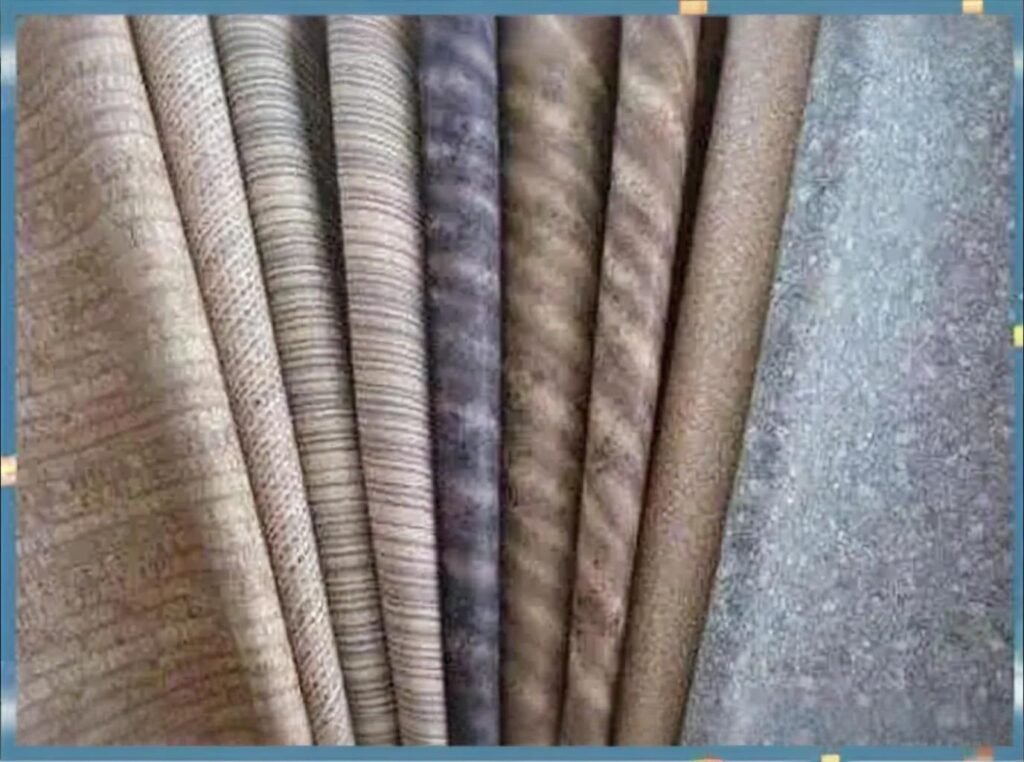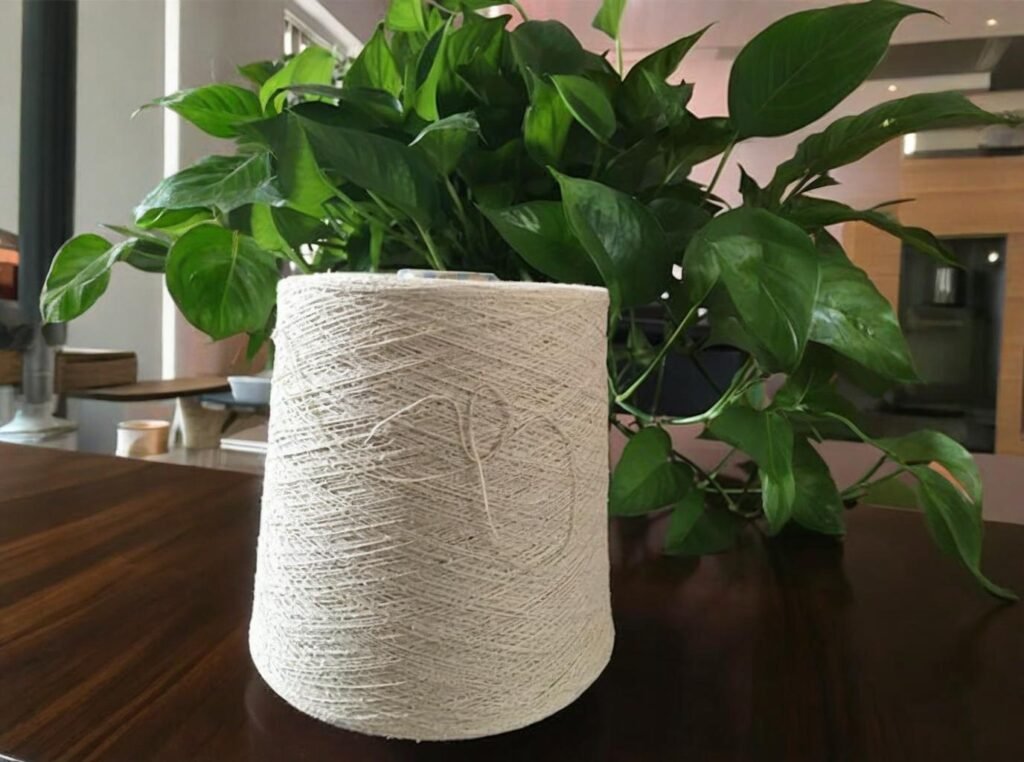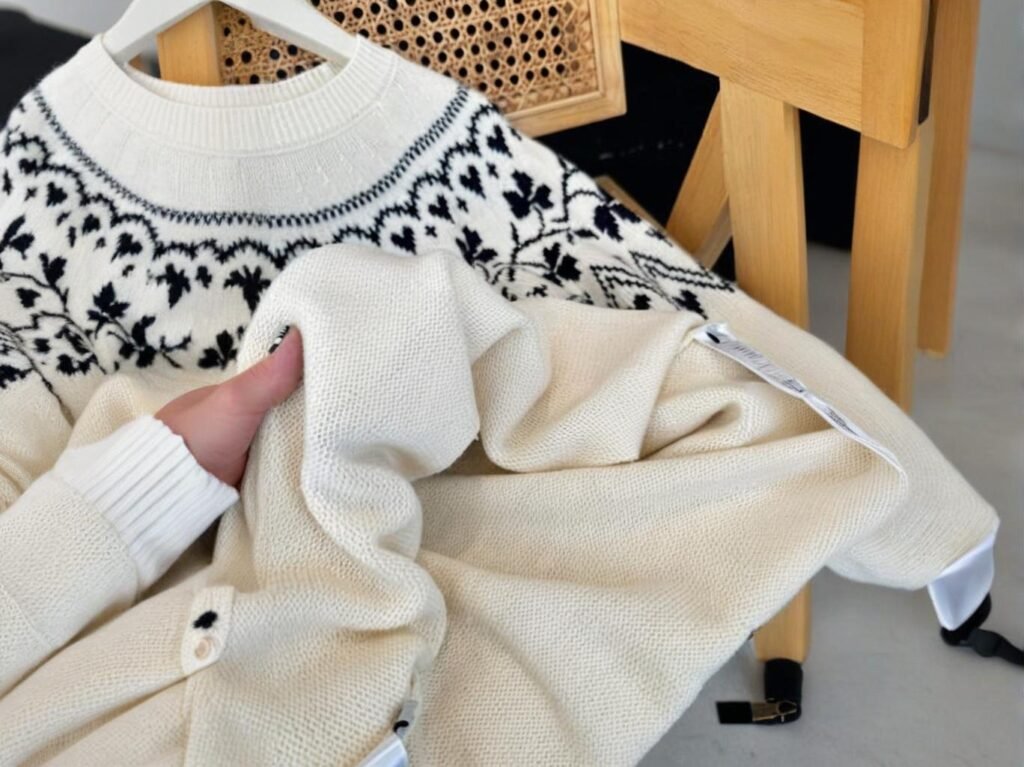In the breakneck world of fast fashion, where styles go from sketchpad to storefront in mere weeks, brands can’t afford delays, shrinkage, or color fading. That’s why acrylic fabric has become a quiet powerhouse in many trend-driven supply chains. Whether it’s oversized sweaters, vibrant winter scarves, or statement knitwear, chances are you’ve worn acrylic without even knowing it.
Acrylic is a synthetic textile made from polyacrylonitrile, valued in fast fashion supply chains for its wool-like texture, vivid color retention, lightweight structure, and low manufacturing cost. Its rapid production turnaround and dyeing efficiency make it especially useful for brands with short lead times and seasonal demands.
But it’s not just about price and speed. Acrylic has evolved—today’s fibers are softer, more stable, and come in blends that mimic luxury fibers with surprising accuracy. Take for example a UK-based fashion retailer that used 100% acrylic sweaters for a holiday collection. The line sold out in 12 days, returned only 3% of the inventory, and had a unit cost 40% lower than their prior cotton-wool blend.
This article takes you deep into the fiber structure, supply chain logic, product categories, and environmental critiques of acrylic—so you can evaluate if it’s the right material for your next apparel collection.
What Is Acrylic Material and How Is It Manufactured for the Fashion Industry?

Acrylic is a man-made synthetic fiber derived from polyacrylonitrile, created through a chemical process involving petroleum-based compounds. It’s known for mimicking the softness and loft of wool while offering superior color vibrancy and affordability.
How Acrylic Is Produced for Apparel Use
Raw Material & Polymerization Acrylic begins as acrylonitrile, a by-product of petroleum, ammonia, and oxygen. Through suspension or emulsion polymerization, it transforms into polyacrylonitrile (PAN)—a solid polymer ready for fiber creation.
Fiber Spinning Methods There are two primary spinning processes:
- Wet Spinning: PAN is dissolved and extruded into a coagulation bath.
- Dry Spinning: PAN is extruded into warm air, evaporating the solvent.
| Spinning Method | Strength Output | Cost Efficiency | Common Use |
|---|---|---|---|
| Wet Spinning | Higher strength | Higher cost | Outerwear, sweaters, blended knits |
| Dry Spinning | Medium strength | Lower cost | Fast fashion apparel, accessories |
Post-Treatment & Blending Acrylic fibers are stretched, washed, and heat-set to improve softness, flexibility, and dyeability. They’re often blended with:
- Wool for softness
- Polyester for wrinkle resistance
- Elastane for stretch
Real-World Use: A major Spanish retailer uses a 70/30 acrylic-wool blend for its fall-winter scarf line due to fast dyeing cycles and smooth drape.
Dyeing Efficiency Acrylic holds cationic dyes exceptionally well, making it ideal for vibrant hues and seasonal color rotations. The dyeing process is also less water-intensive than cotton, speeding up finishing cycles.
How Does Acrylic Compare to Natural Fibers Like Cotton and Wool in Apparel?
While acrylic mimics wool in texture and feel, it offers superior production flexibility, better cost margins, and greater color range—making it a go-to option for trend-centric fast fashion labels operating on tight deadlines and budgets.
Head-to-Head Comparison with Natural Fibers
| Property | Acrylic | Cotton | Wool |
|---|---|---|---|
| Hand Feel | Soft, fluffy | Soft, breathable | Warm, luxurious |
| Warmth Retention | High | Moderate | High |
| Color Brilliance | Excellent | Moderate | Moderate |
| Shrinkage Resistance | High | Low (shrinks easily) | Low unless treated |
| Cost Per Meter (avg.) | $1.50–$3.00 | $2.00–$4.50 | $8.00–$15.00 |
| Production Speed | Fast | Moderate | Slow |
| Biodegradability | Low | High | High |
Texture and Drape Acrylic can be engineered to match a range of tactile finishes:
- Cashmere-like softness (acrylic-viscose)
- Wooly loft (acrylic-wool blends)
- Flat knits for sweaters and thermalwear
Shrinkage and Durability Unlike cotton and wool, which can shrink under heat or moisture, acrylic retains shape after repeated washes, making it a reliable choice for garments sold in global markets with varying consumer laundering habits.
Visual Appeal & Color Brightness Fashion-forward labels benefit from acrylic’s colorfastness. Dye stays locked in the fiber, creating intense hues that remain bright over multiple wash cycles. That’s why it’s often used in:
- Fast-turnaround printed pullovers
- Statement knitwear
- Promotional sweaters and scarves
Brand Story: A Korean streetwear brand known for seasonal drops replaced its wool beanies with acrylic. They reported a 30% increase in reorder rates from wholesale clients citing “better shelf-life, easier care, and stronger color presence.”
What Makes Acrylic Fabric Suitable for Fast Fashion Production Cycles?

Acrylic fabric is particularly suited to fast fashion because it aligns with three critical needs of the model: speed, scalability, and style replication. Its short production lead time, versatility in design, and lower costs give brands the agility to respond to trends in real time.
Fast Fashion Demands vs. Acrylic Capabilities
Rapid Manufacturing Turnaround Acrylic fibers are synthetic and not dependent on agricultural seasons like cotton or wool. This allows year-round production without the delays caused by crop cycles, animal shearing seasons, or unpredictable harvest yields.
| Factor | Natural Fibers | Acrylic Fabric |
|---|---|---|
| Raw Material Source | Cotton/Wool (seasonal) | Synthetic (non-seasonal) |
| Production Flexibility | Limited by climate | Year-round, factory-controlled |
| Lead Time (Avg.) | 45–60 days | 20–30 days |
Easy Dyeing & Trend Responsiveness Cationic dyes used for acrylic result in shorter dyeing cycles and better color brilliance than many natural alternatives. Brands can introduce multiple seasonal palettes with less worry about color consistency or delays in matching shades.
Cost Efficiency for Volume Manufacturing For trend-driven, high-volume production, acrylic is extremely cost-competitive—especially when ordered in bulk.
Example: A Turkish fast fashion factory producing 50,000+ acrylic knitwear units per month cut raw material cost by over 35% compared to cotton-wool blends while reducing production time by 20%.
Compatibility with Knitting & Blending Machines Acrylic yarns work well with:
- Flatbed knitting machines
- Circular knitting machines
- Warp knitting for fast production
They’re also compatible with digital printing and jacquard applications, allowing brands to create complex textures, prints, or patterns—perfect for Instagram-worthy “limited drop” fashion items.
Which Types of Fast Fashion Products Commonly Use Acrylic Material?
Acrylic is used widely across multiple fast fashion product categories, particularly in cold-season and statement items that require visual pop, volume, and warmth without the weight or cost of wool.
Key Product Applications of Acrylic in Fashion
Winterwear Staples
- Acrylic dominates winter collections due to its wool-like texture and insulative properties.
| Product Type | Reason for Acrylic Use |
|---|---|
| Sweaters | Warmth, softness, fast production |
| Scarves | Lofty texture, bold color options |
| Beanies | Shape retention, stretch, vibrant dyes |
| Gloves | Cost-effective, easy to knit and brand |
Knitwear & Layering Essentials
- Trendy knit vests, cropped tops, and cardigan sets often rely on 100% acrylic or blends for affordability and design flexibility.
Statement Streetwear
- Acrylic allows bold prints, exaggerated shapes, and low-pile knits that mimic luxury aesthetics at entry-level prices.
Case Study: A Canadian teen fashion retailer used 100% acrylic for a seasonal “chunky knit” sweater series. The bright pastel colorways and soft touch led to viral traction on TikTok, selling out in 9 days across 87 stores.
Promotional & Branded Apparel
- Acrylic is frequently used in short-lifecycle products such as:
- Holiday sweaters
- Logo beanies
- School or sports merchandise
- Event apparel
Children’s Fashion
- Parents favor acrylic garments for kids due to:
- Easy care (machine washable)
- Hypoallergenic properties
- No wool itchiness
Blended Uses
- Acrylic is often blended with:
- Wool (70/30) for softness in mid-price garments
- Polyester (80/20) for increased structure and durability
- Spandex (95/5) for stretch and shape recovery
Product Line Example: A European fast fashion chain introduced a limited-edition athleisure sweater made of 85% acrylic, 10% polyester, and 5% elastane, priced at €14.99. It became a bestseller within two weeks of launch.
Is Acrylic Fabric Cost-Effective for High-Volume, Trend-Driven Brands?

Yes—acrylic is one of the most cost-effective textile options available for brands focused on high-volume production and trend responsiveness. Its affordability, fast turnaround, and low MOQ (minimum order quantity) requirements make it especially attractive to mid-market and entry-level fashion labels.
Understanding the Cost-Benefit Ratio of Acrylic
Material Cost vs Natural Alternatives
| Fabric Type | Average Price per kg (Global Market) | Fiber Yield per Garment | Approximate Cost per Garment |
|---|---|---|---|
| 100% Acrylic | $2.00 – $3.00 | High | Low ($1.00–$2.00) |
| Cotton | $3.00 – $4.50 | Medium | Medium ($2.50–$4.00) |
| Wool | $8.00 – $15.00 | Low | High ($6.00–$10.00+) |
Acrylic allows for mass production without excessive capital investment in materials, which aligns with fast fashion’s emphasis on:
- Weekly or bi-weekly product drops
- Short design-to-shelf lead times (often <21 days)
- Cost-effective replenishment cycles
Inventory Risk Reduction Fast fashion thrives on speed and low risk. Because acrylic is affordable, brands can:
- Test seasonal color trends or silhouettes in small runs
- Reorder quickly if styles perform well
- Avoid overstock losses on slow sellers
Brand Case Study: An Indonesian fast fashion brand introduced 8 limited sweater styles using 100% acrylic yarn. Production costs were 42% lower than cotton-wool blends, allowing 2x the SKUs within the same budget—resulting in higher product diversity and sell-through rates.
Factory Advantages Suppliers like SzoneierFabrics offer:
- Low MOQs (as low as 100 meters)
- Free swatching and sample prototyping
- Rapid lead time (as fast as 7–10 days for repeat orders)
This enables brands of all sizes to scale without the burden of massive upfront investment.
How Does Acrylic Perform in Terms of Color Retention, Texture, and Wearability?
Acrylic performs impressively in all three key consumer-facing categories: color vibrancy, texture, and wear comfort. While it doesn’t outperform luxury fibers like cashmere or high-grade Merino wool in all areas, it offers excellent value for fast fashion and mid-range clothing lines.
Evaluating Wearability and Aesthetic Factors
Color Retention Thanks to cationic dye affinity and solution-dyeing options, acrylic offers:
- Rich, saturated colors
- UV resistance (especially for solution-dyed)
- Long-term vibrancy through 10+ wash cycles
| Fabric Type | Colorfastness Score (AATCC TM61) | UV Fade Resistance (ISO 105-B02) |
|---|---|---|
| 100% Acrylic | 4–5 (Very Good) | Grade 4–5 (High) |
| Cotton | 3–4 (Moderate) | Grade 2–3 (Low) |
| Wool | 3–4 (Moderate) | Grade 3 (Moderate) |
Texture & Drape Acrylic has been engineered to feel increasingly natural over time:
- Modern fibers mimic cashmere, lambswool, or angora
- When brushed, it develops a fuzzy, soft hand-feel
- When spun tightly, it maintains a sleek drape ideal for body-contouring garments
Examples of Consumer-Approved Textures
- Brushed acrylic: Used in fluffy scarves and winterwear
- Acrylic-polyester blends: Used in bodycon sweaters and fitted tops
- Acrylic-rayon blends: Used for upscale-feel lounge pieces
Comfort and Wearability Acrylic is lightweight and breathable under most conditions. Though it has lower moisture-wicking ability than natural fibers, it’s:
- Non-irritating (hypoallergenic when processed properly)
- Quick-drying
- Insulative, making it ideal for colder seasons
Product Feedback Example: A UK high-street brand’s winterwear collection switched from 60% wool blends to 100% acrylic brushed knits. Customer reviews reported no perceived drop in softness or warmth, while care instructions became simpler—resulting in a lower return rate.
Wash & Care Performance Acrylic is machine washable, doesn’t shrink, and holds shape well:
- Best washed cold or on gentle cycle
- Doesn’t wrinkle as easily as cotton or wool
- Holds up in folded or hung storage without distortion
What Environmental Trade-Offs and Recycling Challenges Does Acrylic Pose?

While acrylic fabric delivers strong benefits for fast fashion, its environmental impact is one of its biggest criticisms. It is petroleum-based, non-biodegradable, and currently not part of a large-scale circular recycling infrastructure like rPET (recycled polyester).
Sustainability Perspectives on Acrylic in Fashion
Carbon Footprint Acrylic production is energy-intensive and generates significant greenhouse gas emissions during polymerization and fiber spinning.
| Material Type | CO₂ Emissions (kg per kg of fabric) | Water Usage (liters/kg) | Biodegradability |
|---|---|---|---|
| Acrylic | ~20.0 | 70 | No |
| Polyester | ~15.0 | 40 | No |
| Cotton | ~2.1 (but water-intensive) | 10,000+ | Yes |
Observation: Although cotton has lower carbon emissions, its extreme water consumption makes it a trade-off choice. Acrylic wins in water conservation, but lags behind in carbon neutrality.
Microplastic Shedding Like many synthetics, acrylic sheds microfibers during washing, which can enter aquatic systems unless filtered.
- Mitigation strategies include:
- Tightly woven or double-knit constructions
- Cold washing + laundry bags
- Post-production coatings that minimize fiber breakage
Recycling Limitations Unlike polyester (which has established mechanical and chemical recycling systems), acrylic lacks a mature post-consumer recycling infrastructure. Some chemical recycling R&D is underway, but recycled acrylic (rACR) is still rare and expensive.
Brand Note: A few European suppliers are experimenting with closed-loop acrylic made from waste fibers, but production remains low-volume and niche.
Sustainable Alternatives
- Modacrylic (modified acrylic): Can sometimes be produced with less energy, but availability is limited.
- Blended strategies: Acrylic blended with rPET, viscose, or bamboo can reduce the environmental load while keeping performance properties intact.
How Can B2B Buyers Source Custom Acrylic Fabric for Fashion Collections?
B2B sourcing of acrylic fabric for fashion requires technical clarity, supplier transparency, and flexibility in customization. With the right approach, buyers can secure high-quality materials that balance cost, color, and compliance.
Dive Deeper: A B2B Sourcing Strategy for Acrylic Fabric
Step 1: Define Key Fabric Requirements Before contacting a manufacturer, clarify:
- GSM (fabric weight) based on garment type
- Yarn count and fiber blend ratio
- Knit/weave structure (e.g., rib, jersey, jacquard)
- Color specs or Pantone references
- Certifications required (OEKO-TEX®, REACH, etc.)
- Performance attributes (UV-resistance, stretch, pilling resistance)
Step 2: Choose a Manufacturer with Fast Fashion Expertise Look for manufacturers who offer:
- Free sampling & design consultation
- Low MOQ (100–300 meters)
- Lead time under 15 days for bulk
- Quick-response prototyping (3–5 days)
- Multi-style production capability (dyeing, blending, printing, knitting)
| Evaluation Criteria | SzoneierFabrics Capability |
|---|---|
| OEM & ODM custom service | ✅ |
| Fiber blend flexibility | ✅ |
| Fast sampling | ✅ (3–5 days) |
| OEKO-TEX certified | ✅ |
| MOQ | ✅ (as low as 100m) |
| Shipping & logistics | ✅ (global support) |
Step 3: Request Technical Data Sheets (TDS) and Test Results Ask for documentation including:
- Colorfastness results (AATCC, ISO)
- Pilling resistance
- Wash durability test results
- Fabric shrinkage data
- UV resistance (if applicable)
Step 4: Test Before You Scale Order lab dips, swatches, and sample yardage before full production. Run internal fitting, dye-lot control, and customer wear tests for fast feedback.
Client Example: A Scandinavian startup worked with SzoneierFabrics to launch a capsule knitwear line made from 100% acrylic in 4 custom colors. With an MOQ of 200m per color, they scaled to 15,000 units in 3 months after positive initial sales and zero color inconsistencies.
Should Fast Fashion Brands Use Acrylic?
The answer depends on your brand’s values, customer expectations, and sourcing strategy. If you need:
- Speed
- Color brilliance
- Wool-like warmth without the cost
- Low MOQ and fast replenishment
Then acrylic is a highly suitable material—especially when produced with technical precision and environmental awareness. While sustainability challenges remain, the balance of cost, performance, and scalability make acrylic an integral part of many successful fast fashion product strategies.
Partner with a Trusted Acrylic Fabric Supplier: SzoneierFabrics
At SzoneierFabrics, we specialize in custom acrylic fabric production for trend-driven apparel brands, with full B2B support from sampling to bulk fulfillment.
✅ Solution-dyed, brushed, blended, or printed options ✅ Free swatching & sample development ✅ Fast lead times, low MOQ, global delivery ✅ OEKO-TEX® certified and quality guaranteed

